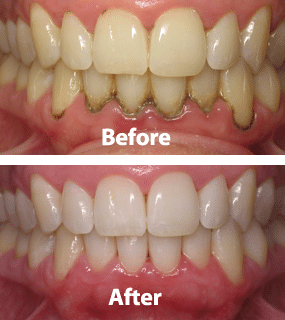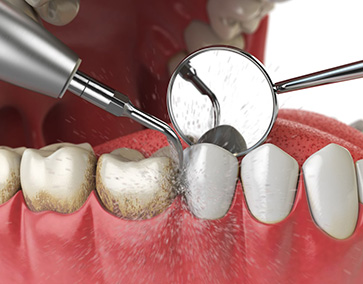Avoid gingivitis Brush your teeth at least twice a day. If you can, brush after each meal. Opt for an electric toothbrush to maximize your cleaning potential. Make sure your toothbrush has soft or extra-soft bristles.

Replace your toothbrush every three months. To address plaque-induced gingivitis , your dentist may prescribe an antibiotic treatment. Gingivitis is a relatively mild form of early-stage gum disease,. Antigingivitis toothpaste.
Toothpaste is a mild abrasive used for cleaning the. Plaque is a sticky deposit that people can get rid of by cleaning their teeth properly. Without proper oral hygiene, plaque can build up along the gum line.
This leads to gingivitis , marked by inflamed gums that bleed when brushed. It occurs when plaque sticks to the teeth and creates a microbial biofilm that usually due to poor oral hygiene. In the warm, moist environment of your mouth, the bacteria proliferate and produce toxins that attack and irritate your gums. Mouthwash can get to plaque bacteria that’s hiding in those hard-to-reach places.
Try Crest Gum Care Mouthwash that is clinically proven to reduce early signs of gum disease. Flossing is a great tool for the treatment of gingivitis ,. You may know this condition by the very sensitive, sore gums that may bleed when you brush and floss your teeth. Constant bad breath or a bad taste in your mouth may also indicate periodontal disease.
It is usually caused by the buildup of bacteria and food particles along the gumline. This buildup irritates the gums and can lead to infection, swelling and other problems. In many cases, gingivitis can be managed and prevented using natural methods, such as good oral hygiene and a good diet. When bacteria build-up in your gums, you may suffer from gingivitis. This bacteria is nothing but the common plaque.
Plaque is not only made up of bacteria but also mucus and food particles that are not cleaned properly from inside the mouth. Many people use a medium to stiff bristled brush,. Consider an electric toothbrush.

High-quality electric brushes have soft bristles. Reassess your brushing method. Angle your toothbrush bristles at degrees toward the. A simple remedy for gingivitis is using salt. Turmeric has a long history in Ayurvedic and Traditional Chinese Medicine in.
A study published in the Journal of Agriculture and food chemistry on. Bleeding gums (known as gingivitis) is the earliest stage of gum disease. It is a sign of increased blood flow to the tissues that support your teeth. These include the gums and pocket that support the teeth, the ligament that hold the teeth in place and the bone underneath. Gum inflammation is the first sign that your gums aren’t in a good state.

It is known to act in two ways in fighting gingivitis – killing bacteria that cause the gingivitis as well as tightening the gums and making them strong. If gingivitis isn’t treate it turns into periodontitis (gum disease), where the gums pull away from the teeth and form “pockets” below the gum line. It shows that there is a need for bacterial activity in that area that causes the infection. The GINGIVITIS remedy is a blend of four homeopathic ingredients that work simultaneously to help reduce redness and swelling of the gums. The remedy also contains a powerful and natural anti-inflammatory agent that will significantly reduce pain and help your pet regain normal eating habits.
Untreated gingivitis can advance to periodontitis, to which there are many degrees. Aggressive periodontitis occurs with people who have gum disease but seem to be otherwise healthy or at least have no other disease that conventional medicine has deemed a cause of periodontitis. Understanding the causes of gingivitis can help you prevent this painful flare-up in your kitty companion.
No comments:
Post a Comment
Note: Only a member of this blog may post a comment.